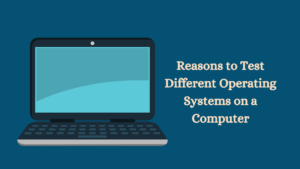
The world of computer operating systems is a vast and exciting one. With so many options to choose from, it can be hard to decide which to use on your device.
While there’s no single right answer, trying out Operating Systems can help you find the best fit for your needs. Here are 12 reasons why you should explore different OS.
1: Features – checking various operating systems means having access to features and updates that might not be available with your current system.
Companies such as Microsoft, Apple, and Google regularly make improvements and introduce new features that could improve your experience.
2: Compatibility – If a particular piece of software or hardware isn’t compatible with your operating system, switching to a different OS may solve the issue.
Some programs are designed for certain systems, meaning that other OS won’t be able to run them properly or at all – trying out a new operating system could be an effective solution for compatibility issues.
You could work on the OS X delete partition, for example, and make some room on the drive for other operating systems that you can then test, including software that is not compatible with the OG system.
3: Security – Operating systems today offer increased security measures designed to protect users from online threats, such as viruses and malware attacks.
Before deciding on an OS for work or personal data, it might be worth exploring the various security settings each system offers in order to determine which one provides the most effective defense against potential threats.
4: Customization – Different operating systems offer varying levels of customization capabilities when it comes to personalizing device settings according to user preference.
Whether you prefer a sleek minimalistic look or enjoy tinkering with advanced settings, testing different systems could give you more control over how your device looks and behaves when in use.
5: Performance – Operating systems often have different performance speeds, depending on their hardware requirements and design principles.
Some might be faster than others, even if they both feature similar specs under the hood.
Installing multiple OSs allows you to compare speed between them, so you can figure out what best suits you as far as efficiency when running tasks or applications that require higher processing power, such as gaming or video editing programs, etc.
6: Price – Most modern operating systems are free-to-use, but some may come with a fee depending on what type of license agreement is offered by the developer or manufacturer.
If cost is an issue when considering an OS, then it is worth investigating multiple options before making a purchase decision since prices vary widely from platform to platform.
7: Accessibility – Different types of users have different accessibility needs based on their abilities; some platforms may include special tools designed specifically for people living with disabilities, while others don’t provide the same level of support built into their interface design structure.
Exploring various operating systems can ensure these users get the special features they need without needing any third-party assistance.
8: Experimentation – Having multiple operating systems installed on your machine gives you room for experimentation.
Playing around with different configurations or settings can result in discovering something new that works better than what you had before, or even uncovering unexpected bugs, which could become useful knowledge down the line.
9: Flexibility – Switching between two (or more) operating systems allows you flexibility when using specific programs, eliminating the need for rebooting every time you want to run something more reliable in another environment.
This also helps save time if there are two separate tasks that require access to two distinct platforms.
10: More Knowledge – Exploring operating systems gives users an opportunity to learn about them firsthand.
Understanding how these different environments work together can give valuable insights into computing as a whole, as well as into how each individual component contributes to making up an effective system overall.
11: Variety – As mentioned earlier, there are lots of great options out there, so having multiple choices gives you greater control over what kind of experience you have when accessing digital content.
Being able to switch between various platforms means that more features are available instead of being confined within just one existing framework.
12: Redundancy & Backup Options – Just because something works perfectly now doesn’t mean it will remain like that forever.
Installing multiple versions allows users peace of mind, knowing they have backup plans should anything happen unexpectedly with their primary source, resulting in loss of data, time, money, etc.
It also offers redundancy by allowing secondary sources (i.e., alternative versions) to provide continuity during these unforeseen circumstances.
Final Thoughts
In conclusion, trying out all kinds of operating systems has its advantages, especially given today’s ever-changing technological landscape.
Whether it’s discovering new features and enhancing performance, gaining improved accessibility and safety measures, finding cheaper alternatives, or simply having fun experimenting.
We believe everyone should explore beyond their comfort zone and experiment with multiple approaches as part of their computing journey.